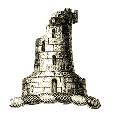Les Médiévales de Domfront
22ème édition
1, 2, 3 août 2025

A little history
Once upon a time there was Domfront ...

WILLIAM THE CONQUEROR
Between 1048 and 1052 Geoffroy II Martel, count of Anjou, tried to control the region. His attempt provoked a reply from William the Bastard, Duke of Normandy (future Conqueror), who came to besiege and take the castle, de facto confiscated from the Bellême. The region, the Passais, was annexed to Normandy; it is the part of the duchy which became Norman the latest. On the religious level, it continued to depend until the revolution of the bishopric of Mans.
HENRI I BEAUCLERC, LORD OF DOMFRONT
In 1087, on the death of the Conqueror, Robert II de Bellême drove out the ducal garrison and took over the castle. Ordéric Vital, a biased chronicler, describes him as a tyrant. It seems that the population of Domfront rebelled against him in 1092, and gave themselves to Henry, 3rd son of William the Conqueror, who had not received any estates during his father's succession. This was the origin of Domfront's fortune in the 12th century and beyond, because shortly after, in 1100, on the death of his brother Guillaume le Roux, Henri Beauclerc became King of England, then Duke of Normandy in 1106 after his victory against his other brother Robert Courteheuse at the battle of Tinchebray, not far from Domfront. He had thus reconstituted his father's domain. From then on, the Lord of Domfront was none other than the Duke-King. Powerful and rich, he completely remodeled the castle, enlarged its enclosure and built, perhaps around 1120, the enormous keep of which there are still vestiges. It was also a period of prosperity for the abbey of Lonlay, which rebuilt its abbey church (the transept and its interesting series of capitals remain from this period), and its priories: Saint-Michel de Goult, and especially at Domfront Saint -Symphorien, located within the walls of the castle, and Notre-Dame-sur-l'Eau, below the spur.

